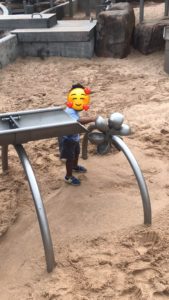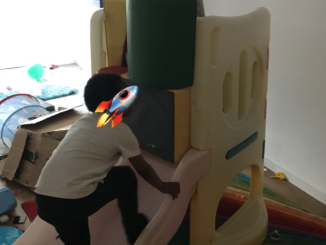
Recently, my family and I visited a sandy playground, and it reminded me of this story about myself and sensory processing.
My son was maybe 18 months old, and he was playing on a playground where the ground was hard rubber. Excellent. All was well.
Then he realized that across a little strip of grass was a playground where the ground was sand. I hadn’t seen that section when I brought him here. Naturally, he gravitated right toward it.
I can’t even tell you how much I hate dry sand. It makes my skin crawl to touch it, to hear the sound it makes, to even think about touching it feels like a gross shuddery feeling in my spine. But my kid loves sand, and he was in the sand before I could really stop him.
I watched from the sideline.
It gradually got later and later, and I realized we were going to need to go soon. On top of it getting later, he would need his diaper changed, we would both need food, etc. Leaving soon was not a negotiable. He was much too young for me to really give verbal prompts to, or expect them to be effective in any way, but I called out loud to him anyway.
No luck. He wasn’t interested in me, he was interested in what he was playing in the sand. And, of course, he was right in the middle of it. No way for me to reach him from the sidelines without having to touch it.
I needed to take some deep breaths and start making a plan. Okay. What if I had to walk onto the sand to get him? I needed a game plan. First step was going to be that I would need to take off my sneakers and my socks and do it barefoot, because touching the sand with my shoes and possibly getting sand IN my shoes was 10x worse to me than touching it with my feet. Then I knew I would hate the few steps it took to get to grass, but the next step would be to carry him to the grass and hopefully mostly wipe my feet off there. I planned for how I’d put my shoes in the stroller and not put them on again until I got home, because enclosing my feet after they’ve touched sand is just Wrong for inexplicable reasons.
I took a deep breath again, I was ready.
And then my kid wandered out of the sand and I was able to get him into the stroller just fine. We went home and I never had to touch the sand.
So what’s the point of the story?
This is *layers* and *layers* of complicated explanation, and language, and problem-solving, and tolerating sensory discomfort, that I can only express and plan and do as an adult. I could not do any of this as a child. Many kids who are struggling with sensory issues don’t even have the language to say what’s making them uncomfortable or what would help — let alone how to break it down into small pieces, like “touching the sand with my feet or with my shoes are BOTH bad, but shoes is worse, and I can tolerate feet for two minutes until we can get to plan B.”
I try to remember this specific story when my kids (that I’m the mom of) or my kids (that I’m the OT of) are having a hard time with something sensory-related. I try to remember how hard it is to be able to verbalize all the nonsensical internal “logic” about what feels bad in your body and what doesn’t, and what would help and what wouldn’t. I try to help them calm themselves, I try to help them problem-solve their way through it, and then I give them space for expressing discomfort while they’re struggling through something.
Because if I have to walk somewhere with sand on my feet, it’s going to be with much lamenting. 😉



